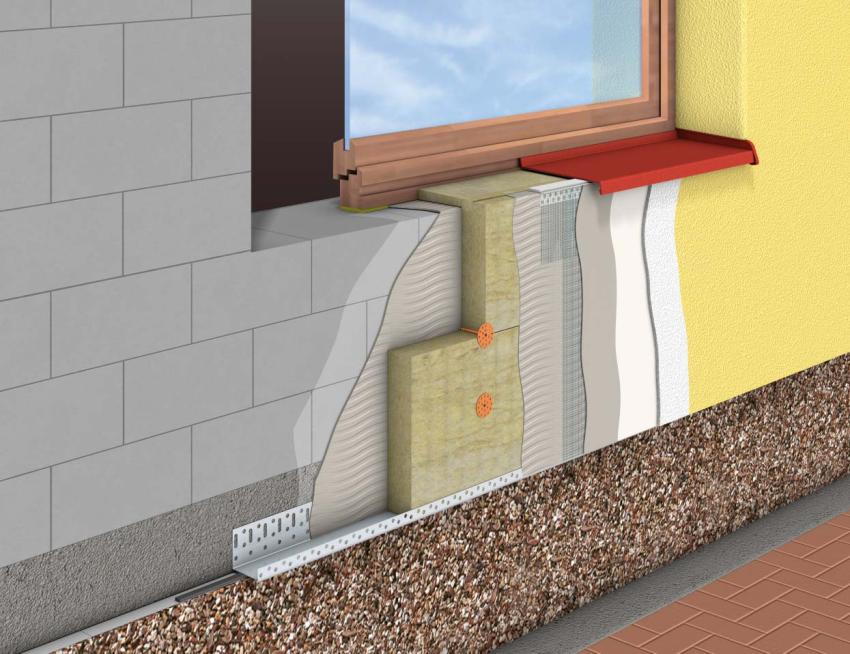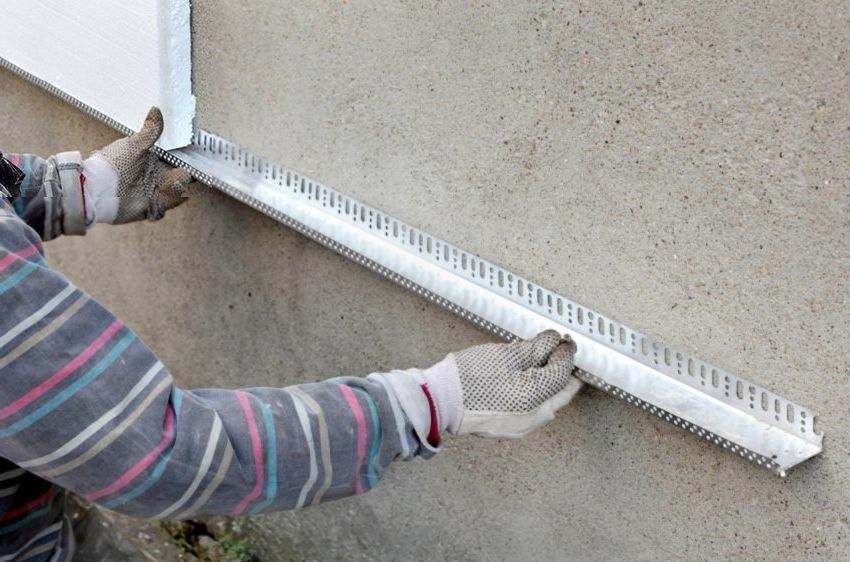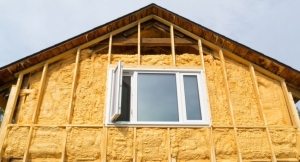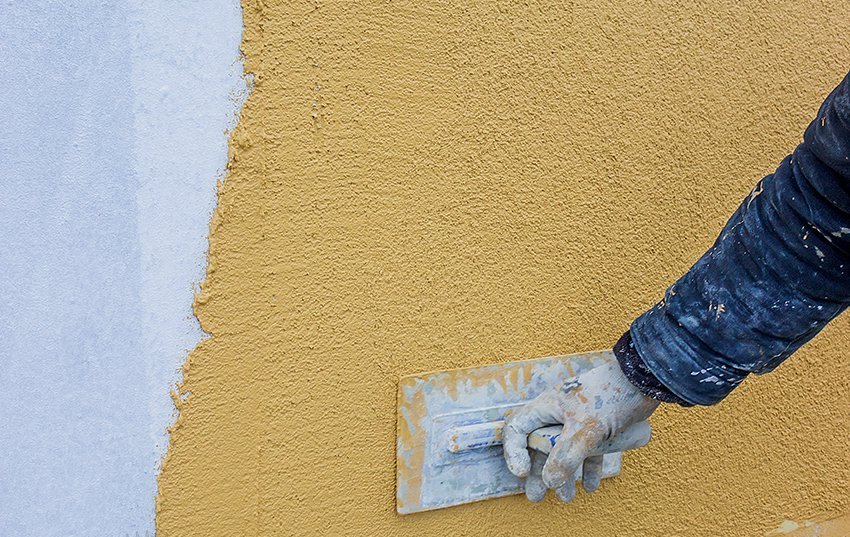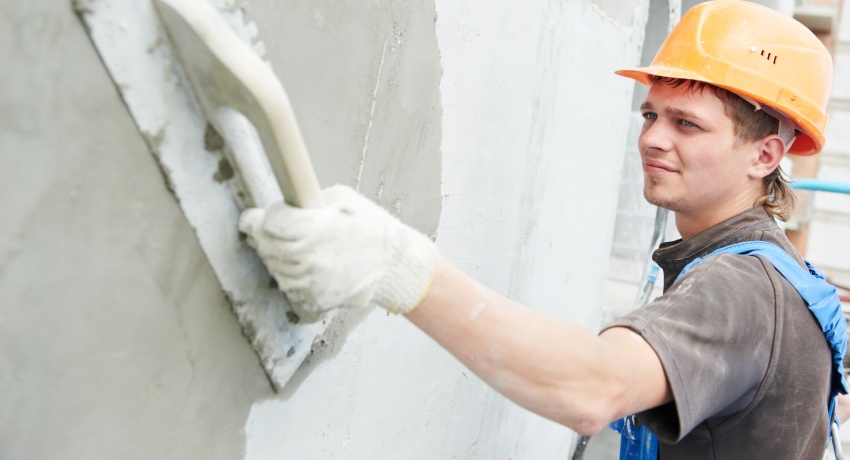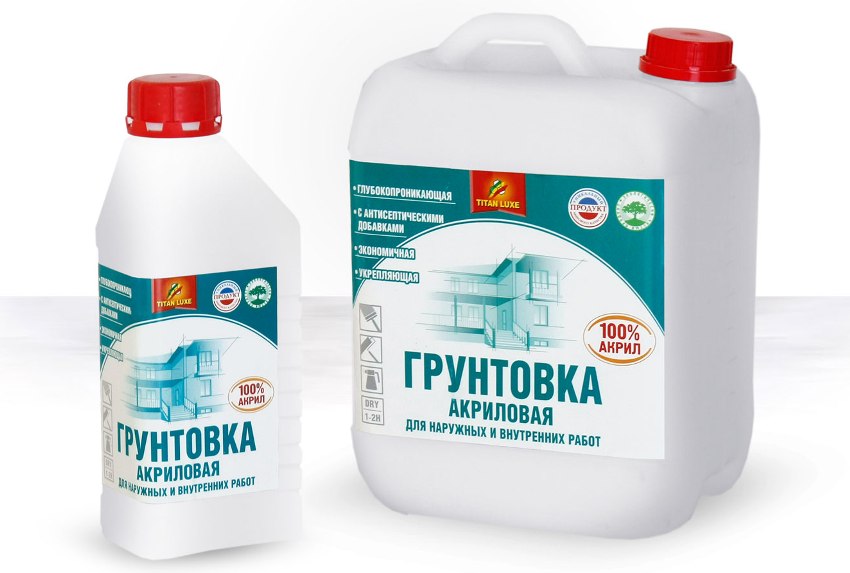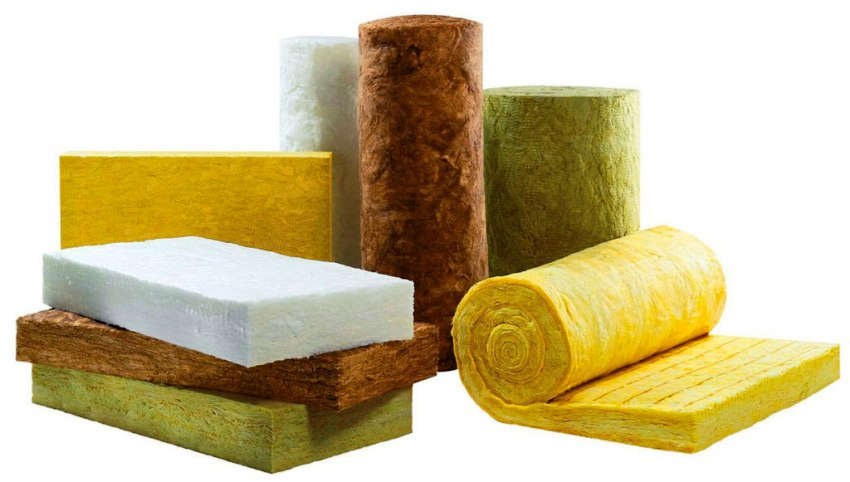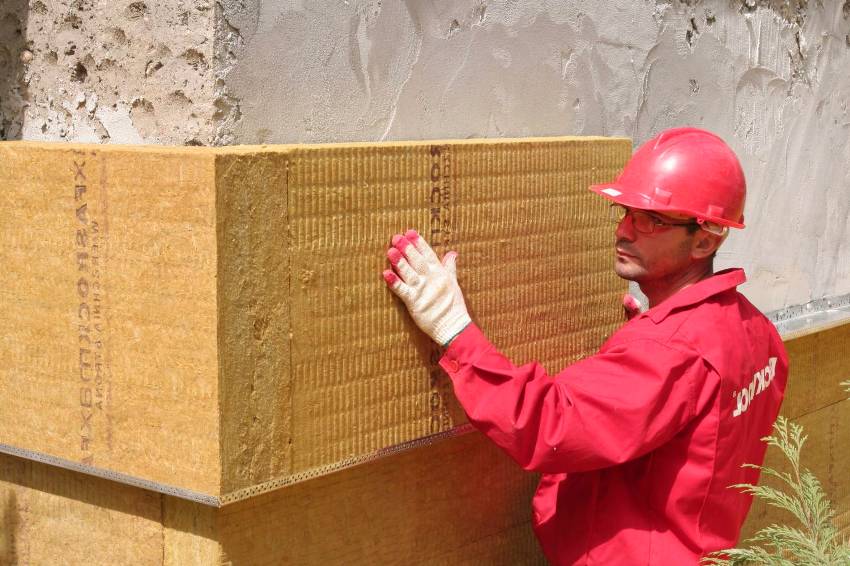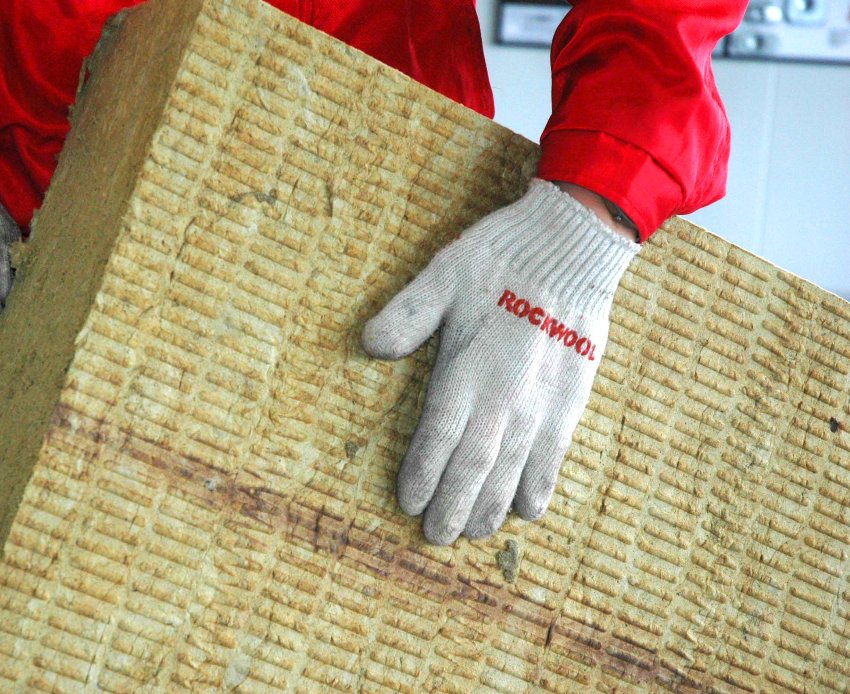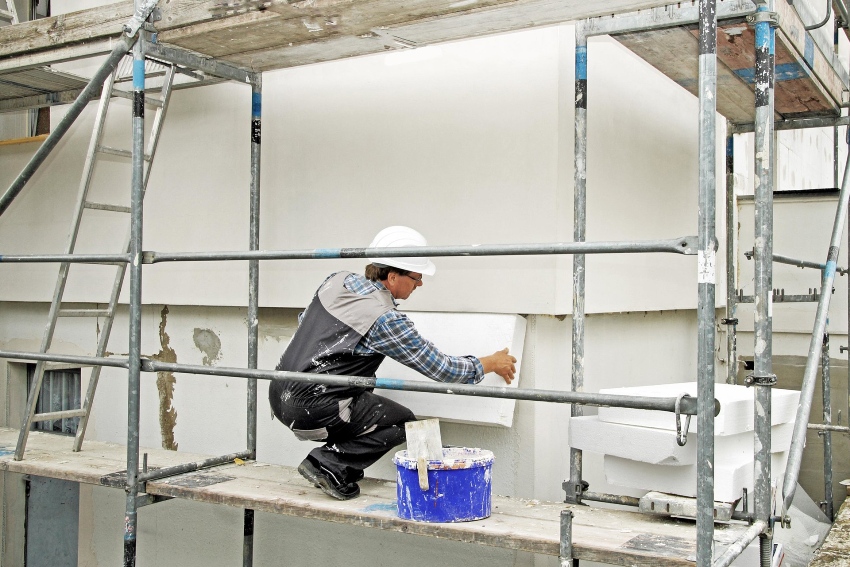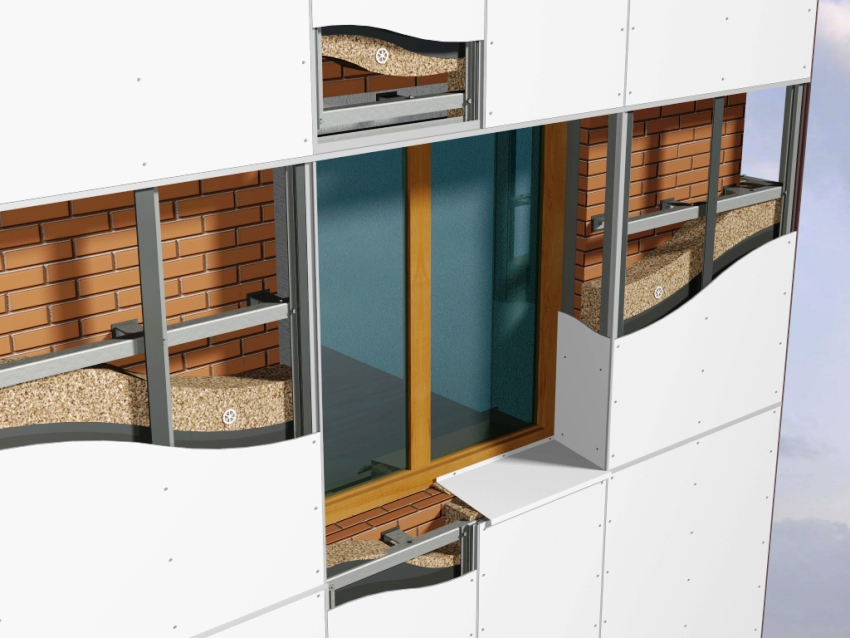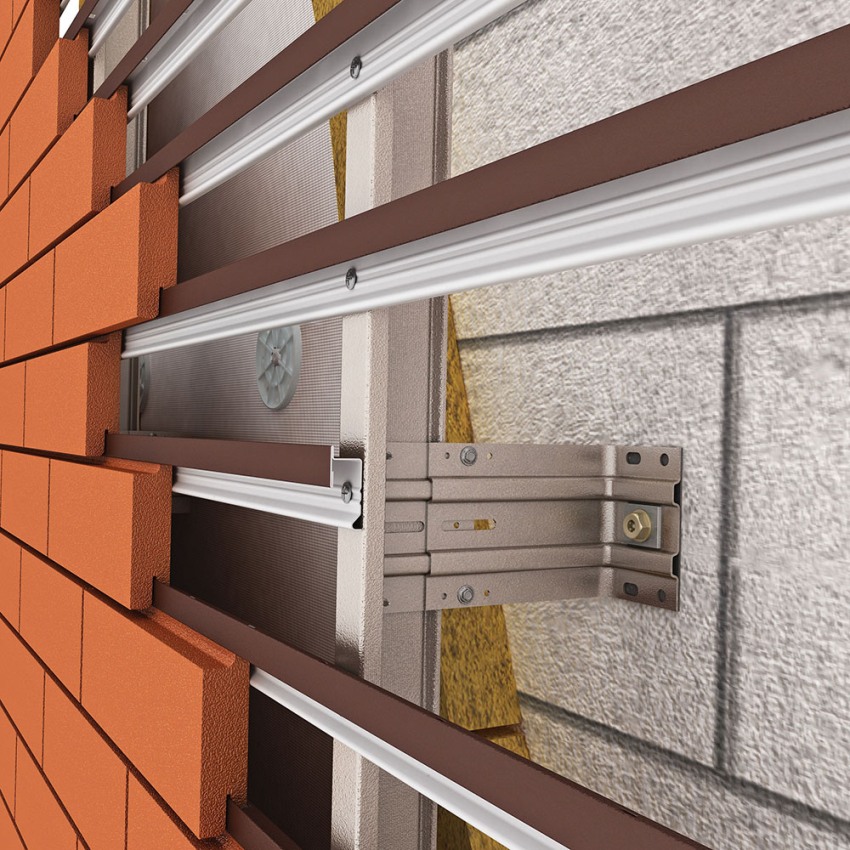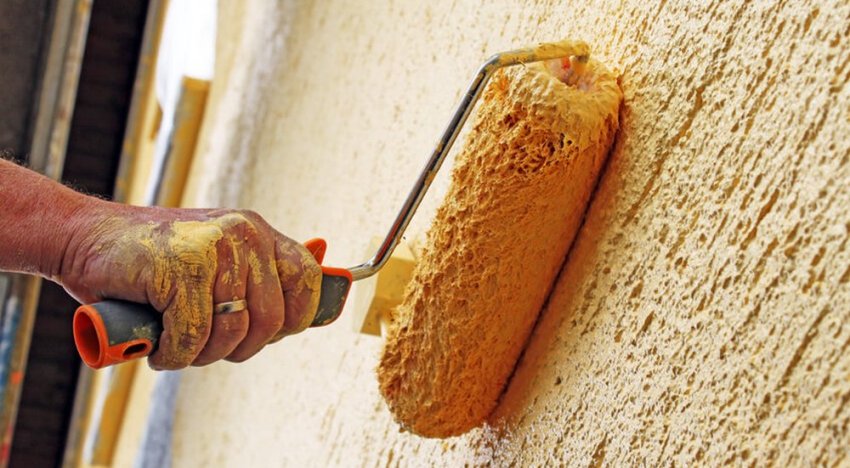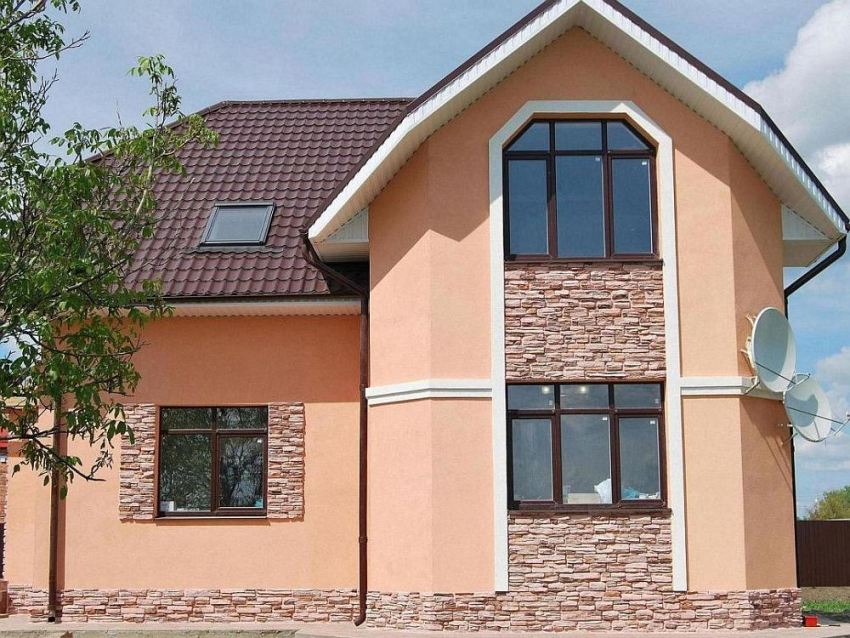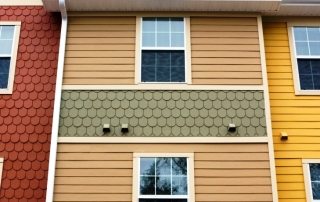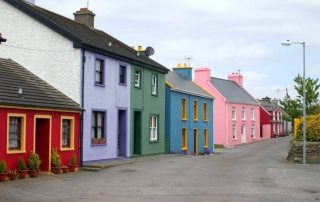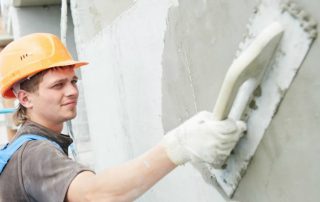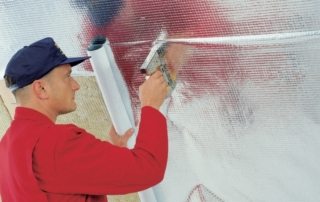High-quality insulation and finishing of the front of the house guarantee significant savings in thermal energy, which is especially important in the context of a constant rise in the price of energy resources. In addition, the complex implementation of the work makes the house more attractive from an aesthetic point of view. There are different methods of warming and decorating buildings, but a wet facade is considered the most modern: the technology of this finishing method is described in detail in this article.
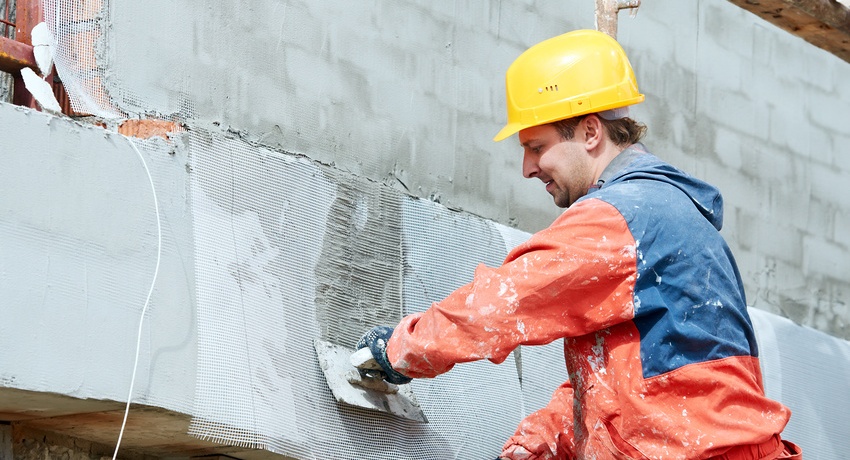
An important advantage of building insulation with the wet method is the long service life of the structure.
Content
- 1 Insulation of facades with a wet method, outside or inside: selection features
- 2 Wet facade technology: step by step instructions
- 3 The basis of a wet facade: materials for work
- 4 Insulation for a wet facade: a variety of materials and features of choice
- 4.1 Mineral wool for a wet facade: materials for production and their advantages
- 4.2 Additional qualities as criteria for choosing mineral insulation for a wet facade
- 4.3 Wet foam facade: material features and requirements for its choice
- 4.4 Requirements for expanded polystyrene plates for a wet facade: price and quality
- 4.5 Consumption of materials for arranging a wet facade: photos of private houses
- 5 Price components of a wet facade per m2
- 6 Ventilated facades: price dictated by quality
- 7 Wet facade technology for mineral wool: instructions, useful tips and secrets of the masters
- 8 House insulation wet facade: summing up
Wet insulation of facades outside or inside: features of choice
Traditional building materials used for the construction of walls, such as brick, wall and concrete blocks, are characterized by increased strength and a fairly long service life. Moreover, they do not have a high level of thermal insulation, and therefore a significant part of the thermal energy simply evaporates through the walls.In order to prevent this undesirable process, the walls are insulated.
Insulation can be both internal and external. At the same time, the amount of material, the amount of work and the very organization of the process inside the house are more profitable and cheaper. At the same time, there are a number of serious arguments in favor of insulating the house from the outside.
Outdoor methods, which include insulating a wet facade, assume the presence of a so-called dew point - this is an area where condensation is released under conditions of temperature changes both in the middle of the room and outside. If the insulation is attached to the inside of the load-bearing wall, there is a high probability of condensation, which leads to increased humidity in the room. Therefore, this method of thermal insulation is less functional and even hazardous to health, since fungi and mold appear on the walls against the background of dampness.
With external thermal insulation, the level of thermal resistance or thermal inertia of the walls increases significantly. In other words, a building insulated from the outside retains heat for a longer time with a significant decrease in temperature outside and heats up slowly in the summer heat.
With external insulation of a house, a wet facade eliminates all kinds of cold bridges, through which, in most cases, the main heat loss occurs in the event of arranging internal thermal insulation.
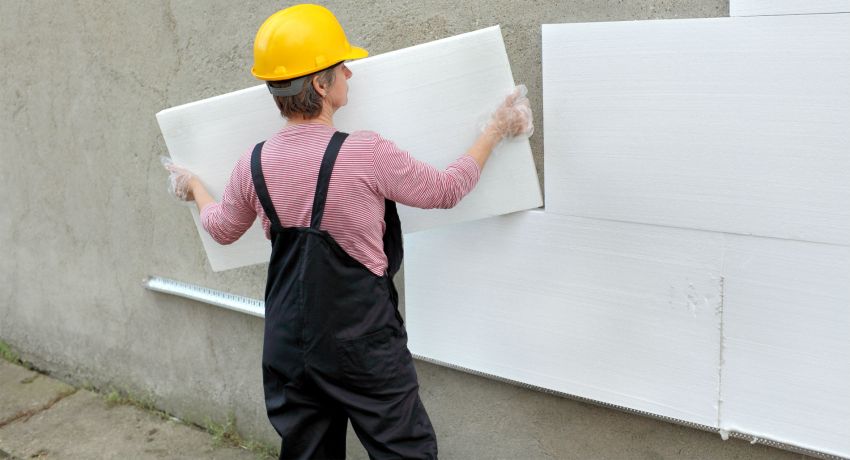
For the installation of a wet facade, there is no need to reinforce the foundation and load-bearing walls of the building
What is a wet facade: technology features
The external method of facade insulation has its own classification. Distinguish between dry and wet technologies. The first option, in turn, includes prefabricated or hinged facades. The main material used in this technology is vinyl or metal siding. The wet facade system is considered to be more practical, highly effective, economical and attractive in appearance.
Important! A distinctive feature of a wet facade is its multi-layer design, where each separate layer plays its own important role in the process of insulation and decoration. For the full implementation of functions, preference should be given only to high quality materials.
Using the wet technique allows you to get not only good quality insulation, but also a beautiful home decor. An important condition is the use of high-quality special solutions. The final stage is the plastering and painting process - these are the key components of the beautiful appearance of the building.
Wet facade technology involves creating a multi-layer cake outside. The layers are fastened to the wall by applying special adhesive solutions, mastics and plaster, which are dissolved in ordinary water. Hence the name - wet facade. The work involves adherence to a clear order of priority in the application of layers: primer, adhesive mixture, thermal insulation boards, additional sizing, mesh reinforcement, plastering and painting.
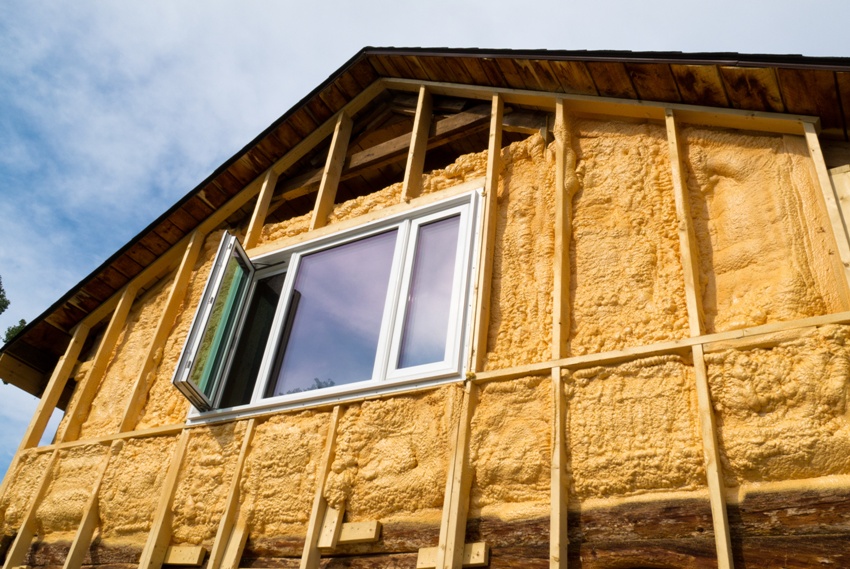
The method of insulating a wet facade is characterized by multi-layer, where each layer plays an important role in the process of insulation and decoration
Each phase involving the use of the wet method, be it sizing, plastering or painting, must be carried out at temperatures above +5 ° C. Not only the quality of work and the degree of thermal insulation, but also the service life of decorative insulation depend on the sequence of work, materials and compliance with the conditions. Otherwise, the facade will soon begin to crack and collapse.
Wet facade: pros and cons outdoor insulation technology
Wet insulation technology has a number of undeniable advantages and a number of disadvantages. The advantages include:
- a high degree of decorativeness and attractiveness of the facade;
- the lightness of the heat-insulating layer, which allows the technology to be applied on buildings with a weak foundation;
- reliable thermal insulation that retains heat in the house for a long time according to the thermos principle and excludes the appearance of "cold bridges";
- additional protection of the house from destructive weather conditions (moisture, freezing, wind);
- reliable sound and vibration isolation;
- durability (a façade made using wet technology can last up to 40 years);
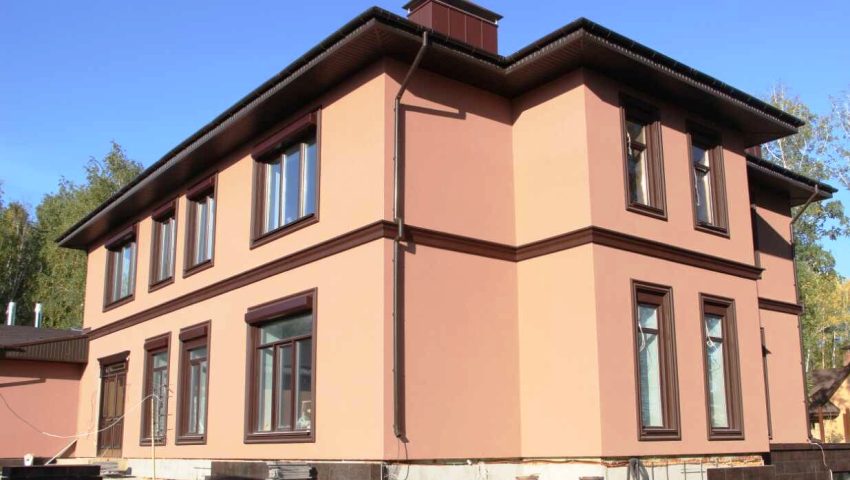
A wet facade can last 30 years without requiring repairs, besides, it can be updated, the color of plaster coatings can be changed
- eliminates the appearance of condensation and, as a result, dampness in the house, which is due to the "breathing" external plaster;
- the cost of a wet facade is acceptable, especially in comparison with other methods of insulation;
- technology does not "steal" usable space in the room.
Speaking about the pros, we should also mention the disadvantages that this methodology has:
- work should be done under optimal temperature conditions outside (if the temperature is below +5 ° C, then it is almost impossible to achieve the desired result);
- each layer requires a certain time to dry, so unforeseen precipitation can negatively affect the quality of insulation in the end;
- the ingress of dust and dirt during work also negatively affects the result, therefore the surface should be protected from the wind.
Useful advice! Insulation of the building with a wet facade should not be carried out during rains. Therefore, it is better to plan the installation in the spring or summer, when much less precipitation falls.
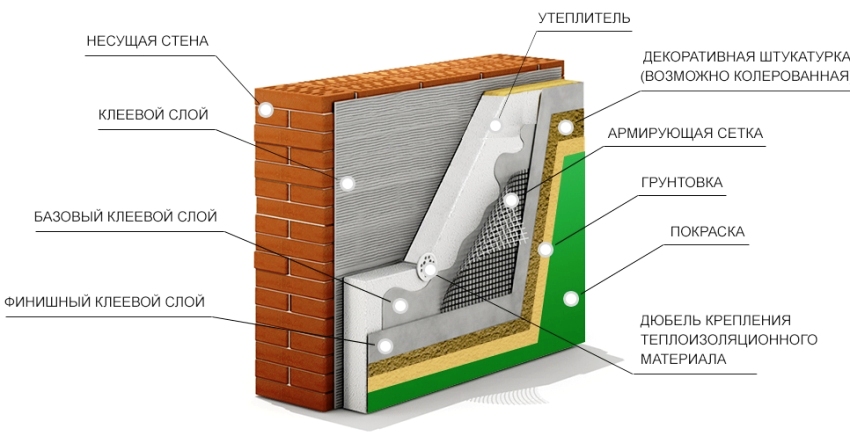
Thermal insulation system wet facade does not require additional space, all its layers are tightly adhered to each other
Wet facade technology: step by step instructions
Based on the above advantages and disadvantages, the conclusion suggests itself that this technology allows you to create high-quality thermal insulation subject to minimal financial investment. The main principle is a clear step-by-step in the application of all layers. The technology of work performance includes three or four stages of forming a wet facade. Photos clearly demonstrate this. Each of the layers fulfills its functional purpose.
| Plaster layer | Main works | Function performed |
| Adhesive or preparatory | Substrate preparation, installation of fasteners and glue priming | Determines the degree of reliability of fastening the future structure |
| Heat insulating | Fastening insulation boards with glue and dowels | Provides a degree of insulation of the building walls |
| Reinforcing | Includes installation of reinforcing mesh | Ensures the strength and reliability of the structure and serves as the basis for the final finishing layer |
| Decorative | Application of decorative plaster in various ways and painting | Protects insulation boards from weathering and provides external beauty of walls |
All stages perform a number of important functions that ensure the overall reliability, strength and durability of the structure, therefore each of them requires a responsible approach and detailed study.
Wet facade: installation technology preparatory phase
Before starting work on insulation, you should take care of preparing the basic base. For this purpose, the walls are thoroughly cleaned and all defects are eliminated. It is necessary to cover the cracks with mortar and level the surface. If the surface is heavily soiled, it is recommended to use detergents.
Next, the surface is tested for strength. To do this, small pieces of insulation are glued to the wall. If they hold securely and do not break into pieces, then you can proceed with the installation. If they easily come off along with the top layer of the wall, then you should clean up again.
After complete preparation of the wall, a primer is applied to it. And after drying - a layer of glue.If the surface of the house consists of material with increased absorption, then the soil layer should be more solid. Better to apply it twice. It is recommended to remove old plaster from window and door slopes in advance.
At the preparatory stage, you should take care of installing the profile strip. The basement profile will help to evenly distribute the load from the thermal insulation plates and protect the lower row of insulation from moisture.
Useful advice! A smooth course of the process can be provided by a special set for facade insulation, sold in hardware stores. Ceresite adhesive mixture for wet façade has proven itself well.
The profile is mounted at a level of approximately 35-40 cm from the ground with a three-millimeter gap between the planks placed horizontally, in case temperature expansion occurs. The profile is attached directly to dowels or screws. Their number depends on the density and weight of the selected material for thermal insulation. Most often they are placed at a distance of 15-20 cm from each other.
Thermal insulation stage for a wet facade: work sequence
The installation of the heat-insulating layer is one of the main stages, since it is the fastening of the insulation plates. The process itself requires adherence to a clear sequence and a number of rules.
Applying glue to the surface of the board. The glue solution is distributed along the perimeter of the material in a wide strip, stepping back from the edge of about 3 cm. In the middle, the glue is distributed pointwise. The main thing is that more than 40% of the slab area is covered with the adhesive mixture. If lamellar mats serve as a heat-insulating layer, then the adhesive solution must be applied over the entire surface.
Laying slabs... Insulation technology for a wet facade implies the installation of insulation "in a run" by analogy with brickwork. In this case, the tiles should be tightly pressed against each other and against the wall. The glue that has come out must be removed immediately. The laying process takes place from the bottom up, starting from the basement profile. It will take 3-4 days for the glue to dry completely.
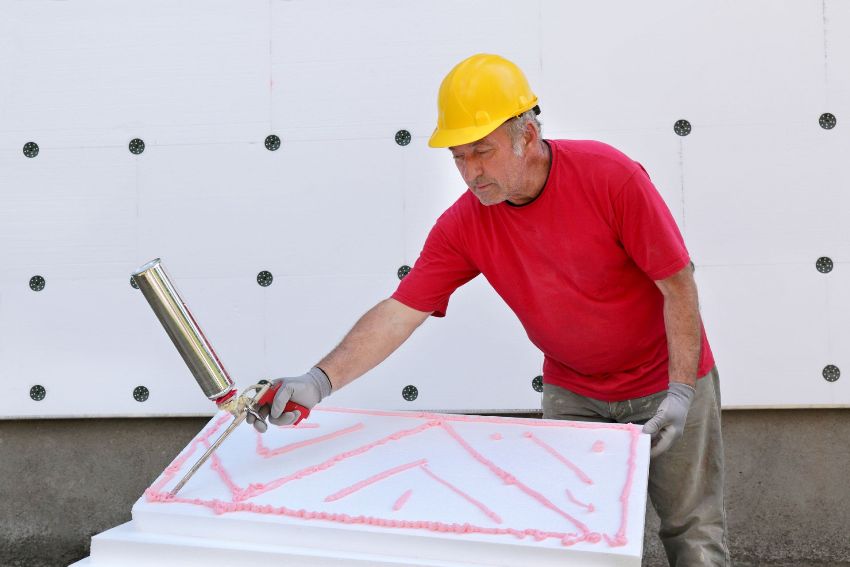
Insulation made of expanded polystyrene can be fixed to the wall using a special foam glue, which is applied with a gun for spray cans with polyurethane foam
Fixing plates with dowels... At the next stage, the thermal insulation layer should be additionally fixed with dowels. Their length should be selected based on the thickness of the insulation layer, adhesive mortar and a margin for deepening into the wall. If the degree of insulation density for a wet facade is high, then 5 cm is enough for a recess, for porous materials this figure should reach 8-9 cm. For 1 m2 of surface, 7 to 15 dowels are needed. Their number depends on the density of the insulation boards, the diameter of the fasteners and the height of the insulation.
Even before installing the dowel, a nest is prepared under it. If properly fastened, the pressure sleeves will fit close to the insulation.
Wet facade: technology laying the reinforcing layer
A reinforced base is necessary to ensure a reliable level of adhesion of decorative plaster over insulation. For this purpose, a special mesh is attached to an adhesive base, sinking it into the middle. Installation of the reinforcing layer begins at least two days after the application of the heat-insulating layer.
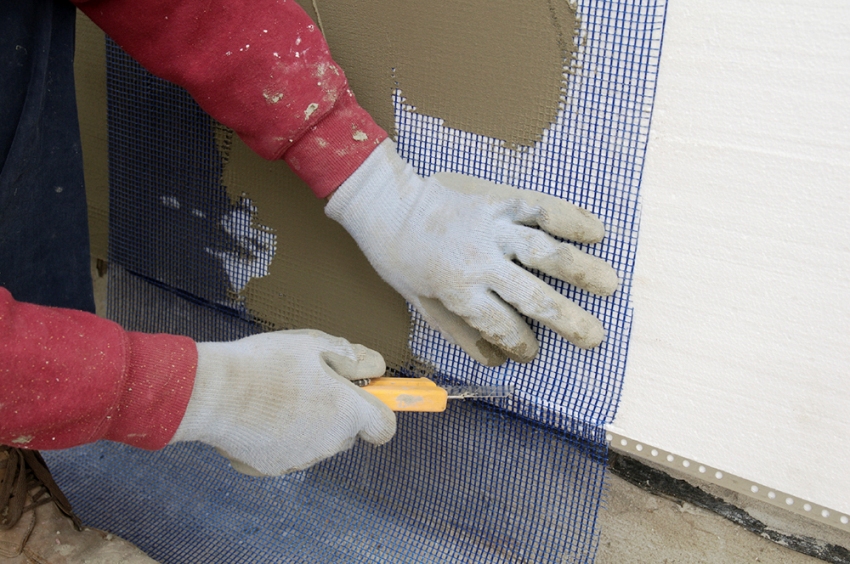
The reinforcing layer of fiberglass is fixed to the adhesive base, which is applied with a special notched trowel
Useful advice! For reinforcement, it is recommended to use an alkaline resistant fiberglass mesh with a durable coating. Otherwise, after a year, the reinforcing layer will begin to collapse, and the plaster will simply crumble.
First, the mesh is attached to the corner slopes in the openings of windows and doors, as well as at the junctions of vertical slopes and lintels. Then they move on to the corners of the building outside, and finally to the rest of the sections.
Related article:
The choice of the type of insulation. Features of materials, their advantages and disadvantages. The main stages of the installation of insulation.
The process itself is the application of a layer of special glue. Then a special reinforcing fiberglass mesh is gradually gently sunk into it. It is laid with an overlap, which ensures the formation of a reliable reinforced base. Excess material is cut off. The total thickness of the reinforcing layer should be a maximum of 6 mm, while the mesh itself is located two millimeters from the surface of the insulation.
When creating a wet facade on buildings with increased loads or on basements, it is necessary to use a reinforced armor mesh that can withstand higher loads. It is the reinforcing layer that plays an important role in the strength of the entire structure. It provides wall resistance to atmospheric and mechanical influences. It is equally important that the mesh resists the alkaline effects of aggressive components contained in the plaster solution.
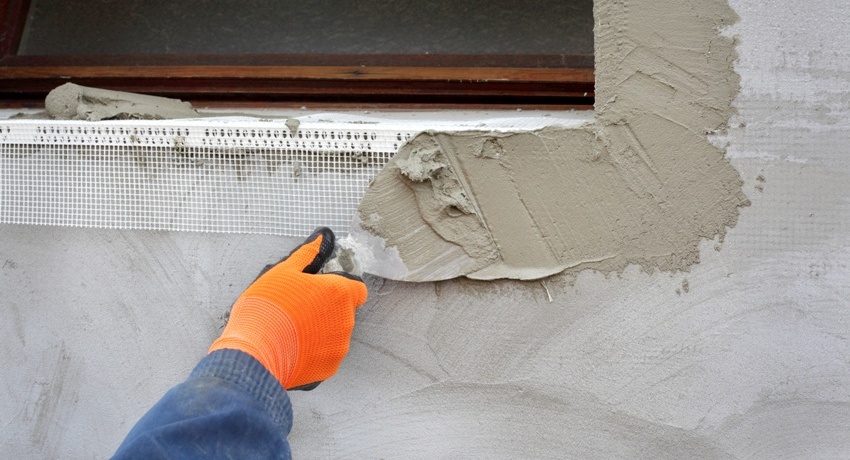
Separate, especially strong corners made of reinforcing mesh are mounted on the corners of the building
Wet facade plaster: decorative layer application technology
The finishing layer plays a double role, as it is responsible for the visual appeal of the walls and at the same time serves to protect the thermal insulation layer from external negative influences. In this case, the plaster must have a certain porosity in order to allow excess condensation to pass through, providing "breathing" to the wall.
Decorative finishing is the final phase of the installation process, carried out using the wet facade technology. The plaster is applied only after the reinforcing layer has completely dried. For this you will have to wait about a week. Moreover, in addition to high decorative qualities, the plastered surface must meet a number of requirements:
- have a high degree of vapor permeability;
- be resistant to atmospheric influences in the form of rain, snow, fog and other precipitation, as well as to the influence of direct sunlight;
- have a high resistance to mechanical damage.
In order for the plaster to easily lay on the insulation, the plates must fit snugly together. The permissible error is a maximum of 3 mm. Otherwise, the next two layers will not be able to mask the flaws, which will affect the appearance of the entire structure. You will either have to apply a very thick layer of plaster, or put up with irregularities. This fact indicates that it is necessary to select high quality materials, as well as to use a special plaster mixture - for outdoor use.
Useful advice! Compliance with the temperature regime affects the quality of work and the durability of the plaster service. As in the case of fixing plates, the working mixture should be applied at a temperature of at least +5 ° C. The maximum indicator is +30 ° С, since excessive exposure to sunlight can negatively affect the quality of the plaster.
Species variety of plaster finishing wet facade
The finishing stage in the complex of works on the creation of the facade by the wet method is the application of a plaster layer. To organize the heat-insulating layer, a variety of decorative finishing techniques are used, the main ones will be discussed below.
Mineral plaster. The material is a binder mixture based on Portland cement.The main advantage of this type of coating is its high level of strength and vapor permeability. This type of finish is resistant to moisture, does not get damp and does not deteriorate. The next advantage is the affordable price. The disadvantages include a narrow choice of colors.
Silicate plaster is a kind of mineral, as it contains liquid glass... Well suited for decorating aerated concrete and foam block walls, as well as for use as part of the wet facade technology, since it has a high level of vapor permeability. However, it should be noted that before applying it, you will definitely need to cover the surface with a layer of a special primer.
Acrylic plaster basically contains a resin in the form of an aqueous dispersion. The positive qualities of the material are elasticity and a high degree of adhesion to different surfaces. To avoid cracking, the acrylic is applied in a thin layer to a reinforced fiberglass mesh treated with a sealant.
Silicone plaster has a number of unique properties, it is very flexible and viscous. Even if the building collapses, the wall covered with a silicone layer will not crack. This finish is available in a wide range of colors and is self-cleaning. Thus, the wall itself, under the influence of precipitation, will be cleared of dust and dirt.
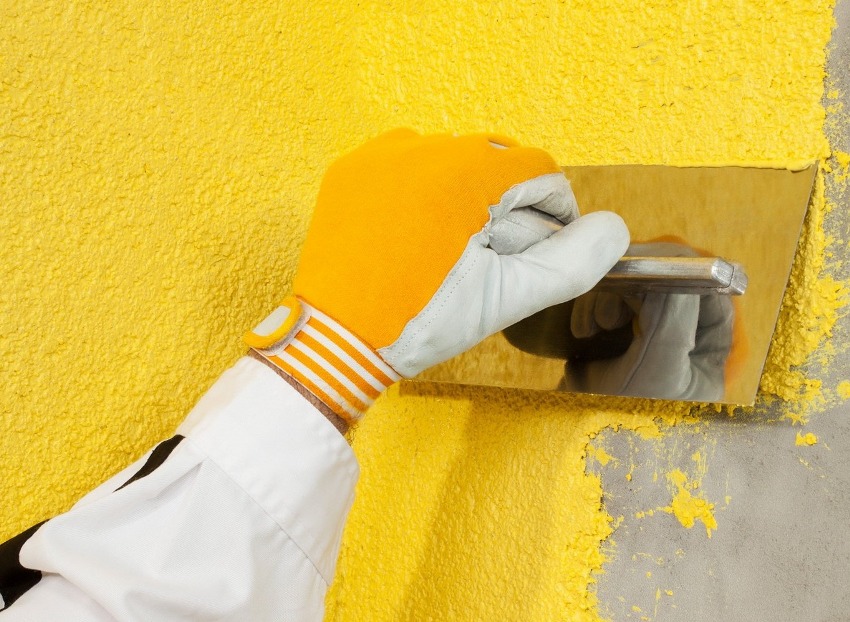
After carrying out the warming and strengthening work, they proceed to facing the facade with plaster
The basis of a wet facade: materials for work
Having considered in detail all the stages of work, a novice master will be able to assess his strength in terms of an independent device of a wet facade with insulation. If a positive decision is made, then care should be taken to have a full arsenal of materials and tools. The list below will allow you to take into account all the details. So, this technology assumes the presence of basic materials:
- Thermal insulation boards as a base material require a special approach in selection. It is necessary to calculate in advance the thickness of the plates, on which the degree of thermal insulation depends, and to study the characteristics of different heaters.
- The basement profile is selected taking into account the width and thickness of the selected thermal insulation boards. The number is calculated based on the size of the building.
- The mesh for the wet facade, which serves to strengthen the entire structure, is most often a roll of fiberglass. For heavily loaded buildings, more reliable meshes are used.
- Wet facade adhesive is used to fix the slabs. They select it in accordance with the selected insulation.
- Decorative plaster is applied at the final stage. You can use ready-made formulations.
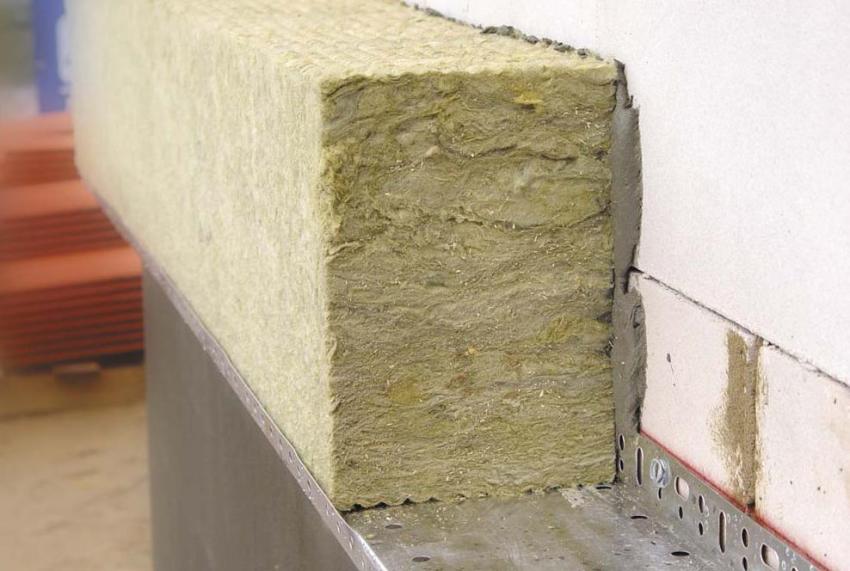
For the installation of a wet facade, you should take care of the availability of a full arsenal of the necessary materials
Useful advice! In the choice of materials for the manufacture of a wet facade, first of all, they are guided by the qualities and characteristics of the selected insulation. For example, mineral wool glue is not suitable for fixing foam boards and vice versa.
Additional materials for creating a wet facade with your own hands
The above list of materials is considered basic, but far from exhaustive. If you do not take care of purchasing a complete set before making a wet facade, then a number of inconveniences and difficulties may arise in the process of project implementation.
The primer is applied at the preparatory stage in order to ensure better adhesion of the slabs to the wall. The type of primer is selected in accordance with the type of decorative plaster.
The composition for plastering protective and reinforced layers is applied directly to the insulation, although it is often confused with decorative plaster. These are different compositions - and this should be taken into account. One of the main differences is the higher price of finishing plaster.
The paint is intended for wall decoration and serves as a certain protection against atmospheric influences. Do not neglect this material and save on it.
A necessary component is mushroom-shaped dowels. It would seem a trifle, but without them reliable fixation of the plates will not be ensured. Therefore, you should take care of their purchase in advance.
Dowels for fixing the base are a separate element, very important even at the preparatory stage. The length of the dowel-nails depends on the material of the wall where the profile is attached. In the process of mounting the base, you should also take care of the presence of special elements for connection in places of bends and in corners.
In order to purchase a complete set, manufacturers offer complex systems, which already include all the necessary materials and tools for creating a wet facade. At the same time, not every set takes into account the individual needs of the owners, and therefore you need to be careful when buying such sets.
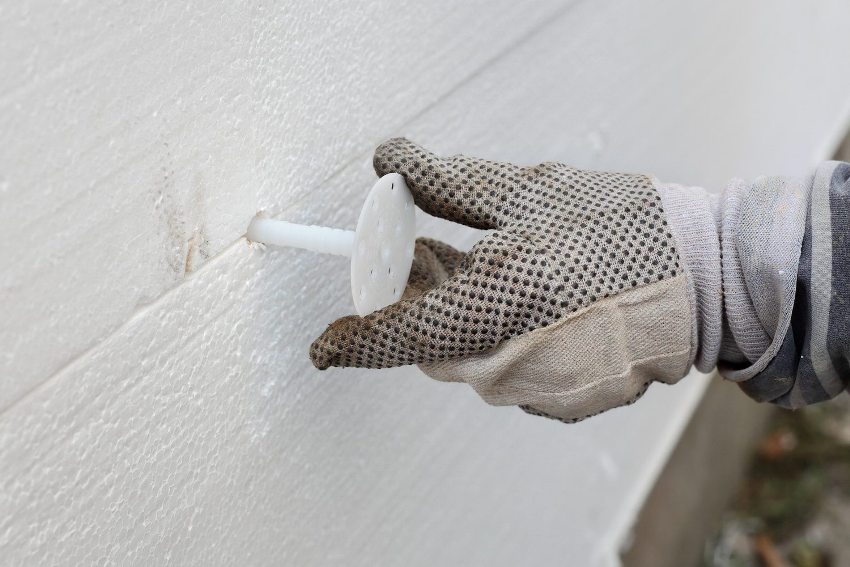
The mushroom dowel is used to fasten the insulation material and is capable of carrying heavy loads due to the shape of its cap
Tools required for wall insulation with a wet facade
The list of tools for performing work on wet facade technology should include almost the entire arsenal of an experienced builder and a number of special devices that will greatly facilitate and speed up the process. In particular, you will need:
- a square required for marking right angles and 45 ° angles;
- building level, designed to determine the degree of deviation of parts from surfaces in the horizontal or vertical direction;
- tape measure for measuring the length and width of various materials;
- a metalwork hammer, designed to work with different materials;
- fine-toothed saw for cutting Styrofoam materials;
- construction mixer for mixing dry building mixtures of sand, plaster, glue, putty;
- rollers for priming at different stages and for painting the finishing layer of decorative plaster;
- Swiss trowels used to cover the surface with various mixtures and to smooth them;
- trowel with teeth, used for pasting and fixing by the "embedding" method of the reinforcing layer;
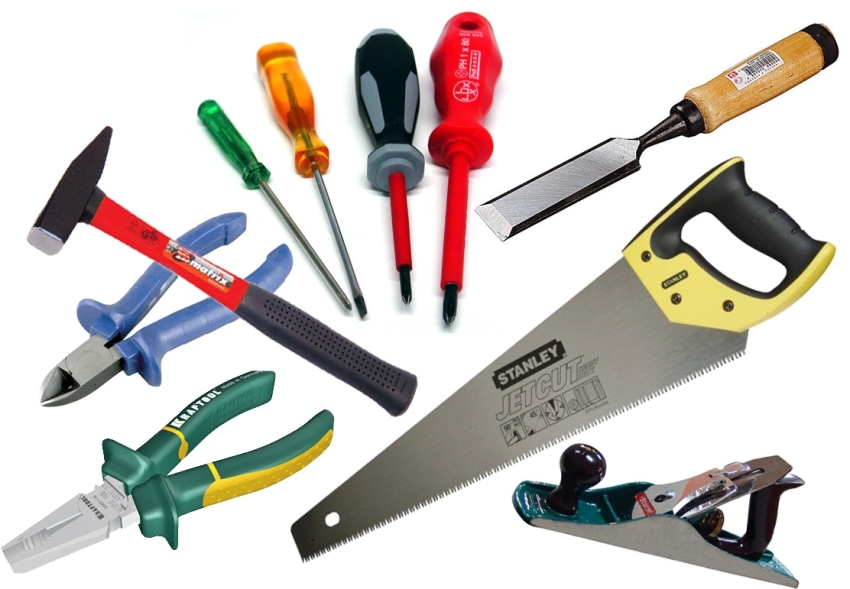
The list of tools for performing work on the wet facade technique includes almost the entire arsenal of an experienced builder
- a simple plastic trowel for applying putty and plastering compounds;
- trowel for easy mixing of the solution;
- spatulas and trowels of various sizes;
- cutter for deepening the dowels when fixing the slabs to the wall;
- sealant gun.
Useful advice! You should take care of purchasing tools at the preparatory stage. This list is maximum and extensive, but it is possible that additional tools may be needed during the work.
Insulation for a wet facade: variety of materials and features of choice
Facade heaters are divided into two large groups - products from expanded polystyrene and mineral wool. Foam materials are lightweight, quick to install and have a high level of thermal protection. The main drawback of the material is its flammability. Mineral wool for a wet facade is an order of magnitude more expensive, while being more reliable in terms of its performance. Plates made of this material do not burn, have a high level of vapor permeability.
The density of mineral wool for a wet facade must be at least 150 kg / m³, and the tensile strength must be at least 15 kPa. It is recommended to give preference to the choice of basalt fiber slabs. As for the polystyrene, for insulation work, you should choose a material of special purpose with low flammability.Experts do not advise in this area to use extruded polystyrene foam, which has low vapor-permeable characteristics and has poor adhesion to the adhesive solution.
Different types of insulation boards are used in different conditions. The choice is guided by the physical and chemical characteristics of the insulation, based on its specific purpose. Moreover, each group of insulation has its own classification.
Minvata for a wet facade: materials for manufacturing and their advantages
So, mineral wool slabs are the best suited for facades. This advantage is due to a number of specific positive characteristics:
- durability;
- fire resistance;
- excellent vapor permeability;
- high level of heat and sound insulation;
- resistance to chemical and biological substances;
- environmental friendliness;
- ease of installation.
In addition, certain types of wool, in particular products based on phenolic binders, are distinguished by a high level of moisture resistance. The most preferred slabs are diabase or basalt wool slabs for wet façades. The price of such a heater is much higher than other analogues, but this is the case when they pay for the quality.
Since the strength of mineral wool should start from 15 kPa, and the material itself should not react with plaster, the use of fiberglass plates in this area is impractical. This is due to the fact that such mineral wool is easily destroyed in an alkaline environment and does not have sufficient tensile strength.

Depending on the production technology and the nature of the raw materials, the fibers of the insulation material can have different geometry, length and thickness.
Fiberglass boards will begin to crumble under the influence of alkalis, which are contained in the reinforced base layer and adhesive solution. The average pH of these materials is 12.5. The corresponding reaction does not begin immediately, but after a couple of years. The destruction is especially intense under the influence of strong winds. Thus, very quickly, a wet fiberglass facade will become unusable.
Additional qualities as criteria for choosing mineral insulation for a wet facade
An important indicator in the selection of thermal insulation boards is the moisture absorption coefficient. It is desirable that its level be at around 15%, since moisture absorbed into the material will lead to its inevitable deformation and adversely affect thermal conductivity. Slabs with a high degree of moisture absorption do not provide the required level of solidity of the facade. As a result, such a structure will not last more than two years.
Useful advice! The density index of the mineral wool of the wet facade should range from 150 to 180 kg / m³. Otherwise, the process of applying the finishing layer becomes more complicated and there is a risk of delamination of the entire thermal insulation coating of the facade.
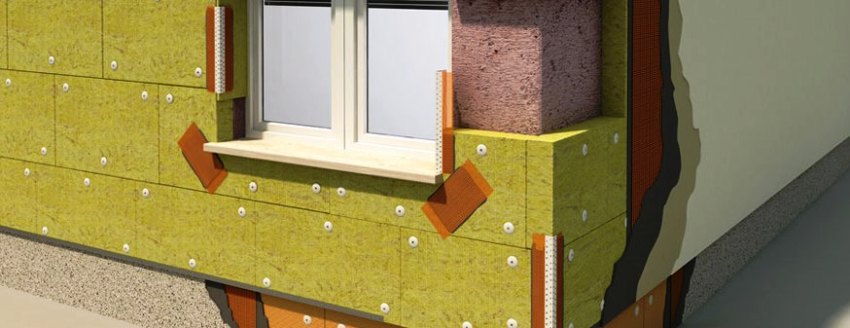
The main disadvantage of mineral wool is hygroscopicity; when wet, the material loses at least half of its thermal insulation properties
The technology of a wet facade for mineral wool involves the selection of slabs in such a way that the degree of vapor permeability from the first (preparatory) to the last (decorative) layer gradually increases. Compliance with this requirement will provide favorable conditions and prevent condensation in the middle of the structure. In the climatic conditions of Russia, most of the time throughout the year, the temperature indicators inside houses are much higher than outside. These conditions greatly increase the likelihood of condensation occurring.
Wet foam facade: material features and requirements for its choice
Another group of heaters has a certain list of positive qualities, the main raw material for which is expanded polystyrene. It should be noted here:
- low cost;
- lightness of the material;
- high thermal and sound insulation;
- vapor permeability;
- environmental friendliness;
- ease of installation.
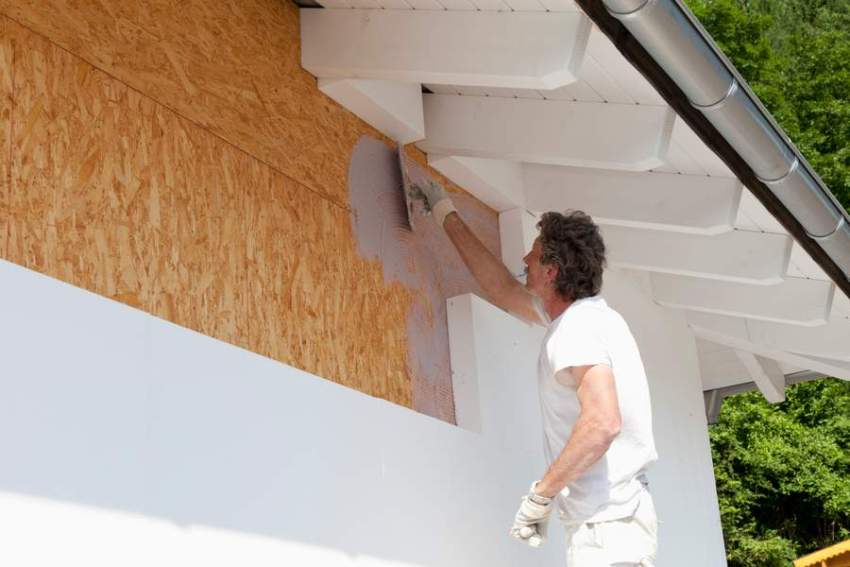
The price of a wet foam plastic facade largely depends on the brand of insulation, the denser this heat insulator, the higher its cost
The list of disadvantages of foam plates significantly exceeds the similar characteristics of mineral wool. The main disadvantage is the flammability of the material. In order to eliminate this defect, manufacturers treat the insulation with special chemical agents - fire retardants. Thus, even in the event of a fire, the spread of fire will be stopped, that is, the flame can extinguish itself.
Fire safety is also provided by special inserts made of non-combustible materials, in particular, from mineral wool. The use of this method has led to the emergence of a separate composite material.
Among other disadvantages of the material is the low degree of biosecurity. Insects and even rodents can settle in the foam. Also, expanded polystyrene plates are more fragile, which creates certain problems during the installation process, and less wear-resistant in operation.
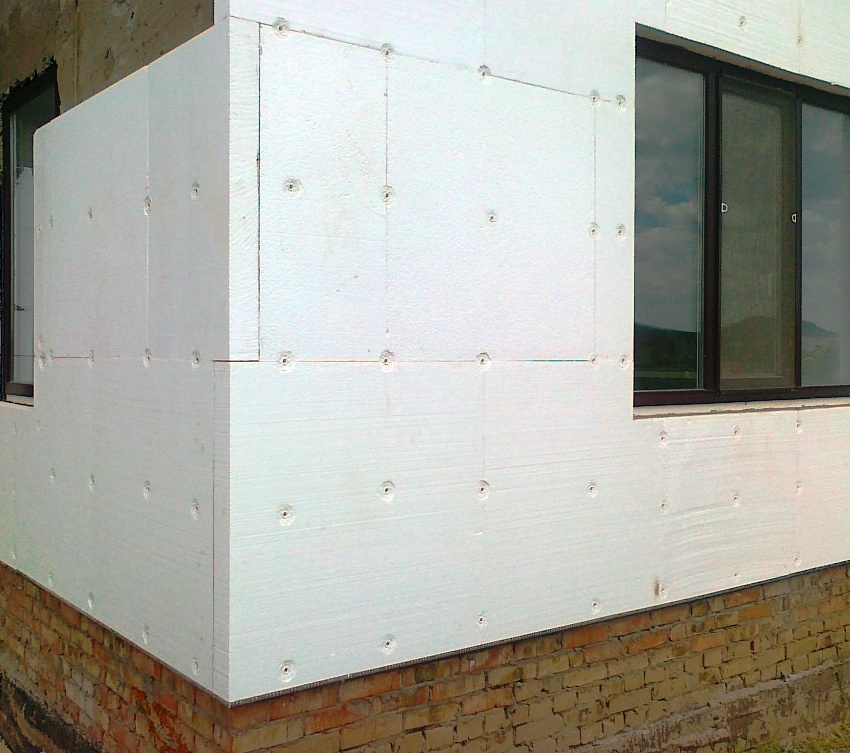
Polyfoam is not afraid of moisture and dampness, therefore it is more often used for insulation outside
Requirements for expanded polystyrene plates for a wet facade: price and quality
Before buying a polystyrene foam material for a wet facade, you should study its characteristics and compliance with all requirements. It must have a tensile strength of at least 100 kPa and a density of 15 to 25 kg / m³.
Useful advice! The choice of material in accordance with all the requirements for it and its correct installation, with strict adherence to the technology of installing a wet facade for insulation, guarantee its service life for 20-30 years. Repair of the decorative layer will have to be done a little more often, but the costs will be much less.
High-quality material can be determined even by external data. Insulation granules should fit as tightly as possible to each other and have approximately the same size. Otherwise, such foam will bring a maximum of problems, starting with the installation process and ending with direct operation. A low-quality coarse-grained material absorbs an increased amount of moisture, which, in turn, entails its deformation and leads to a loss of thermal insulation qualities and early destruction of the facade
The shape of the polystyrene foam insulation boards must be the same as that of a regular rectangle. The error is allowed no more than 2 mm per 1 m. Differences in the thickness of the insulation can be a maximum of 1 mm, and the deviation on the surface of the front plane should not exceed 0.5%. Otherwise, it is impossible to insulate the facade of the house without defects. A wet facade from the outside will have low aesthetic characteristics, and its service life will be reduced several times.
Consumption of materials for arranging a wet facade: photos of private houses
As for other types of construction work, the consumption of materials is approximately based on the required amount per 1m² finished wet facade. Insulating a house outside involves the following costs:
- primer will need about 250 milliliters per 1 m²;
- adhesive solution for fixing heat-insulating plates is spent at the rate of 10 kg per 1 m²;
- the consumption of the insulation itself with a plate thickness of at least 5 cm corresponds to the area to be insulated;
- dowels for fixing the plates will need about 5 pieces per 1 m²;
- the netting for the wet facade is consumed at the rate of 1.3 m² per 1 m²;
- plaster for the leveling layer should be purchased based on the needs of 0.3 kg per 1 m²;
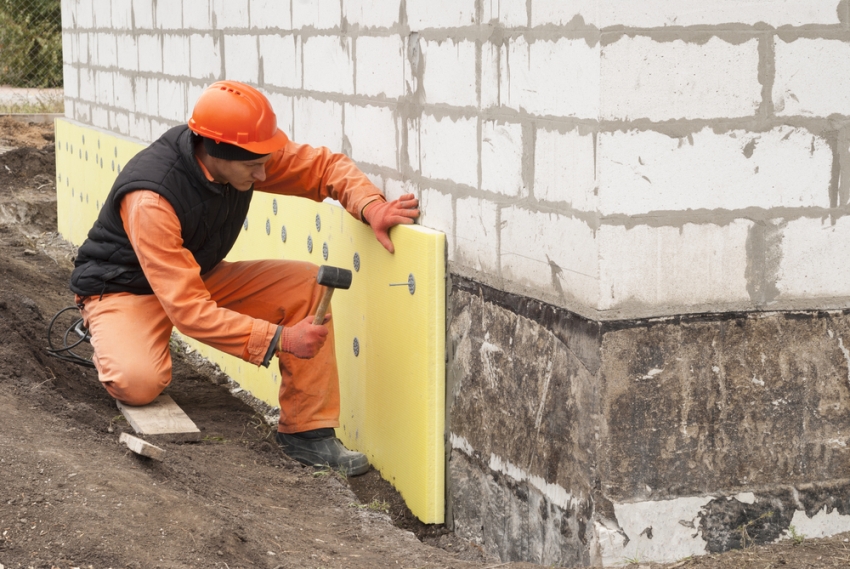
The consumption of materials for insulation by the wet facade method is made based on the required amount per 1m²
- the consumption of primer for the finishing layer is approximately 0.3 kg per 1m²;
- the finished decorative plaster will need about 3 kg per 1 m².
In order to correctly calculate the required amount of materials, you need to follow the instructions on the packaging of the material, and it is better to purchase ready-made kits. The Ceresit wet façade system has proven itself in this market segment. Facade insulation technology using mineral wool slabs involves the use of the Ceresit WM brand.
For insulation with the use of foam using the technology, the Ceresit wet facade is marked VWS. Plates for thermal insulation are treated with an adhesive and fixed to the wall, a special protective layer with a reinforced fiberglass mesh is applied on top. The system of the corresponding brand contains all the necessary materials.
Price components of a wet facade per m2
The price of the finished wet facade includes the total cost of preparatory, installation and decorative work. The main costs are for materials based on their cost per 1 m² for a blank wall.
Important! The main component of the total cost of a wet facade is the price of insulation, which depends on its type, density and mineral additives.
The total cost of the finished system is the total cost of the constituent components:
- adhesive mixture for fastening insulation;
- plastering solution for the base;
- mixtures for decorative plaster;
- fiberglass mesh for the reinforced layer;
- dowels and other fasteners;
- two types of primer;
- thermal insulation boards.
Complete systems usually do not include the cost of additional and optional parts, various profiles and auxiliary fasteners. Also, not all manufacturers offer thermal insulation materials in the complex. In this case, you should keep in mind the average cost of insulation. For example, the average price of mineral wool for a 10 cm thick wet facade is about 650 rubles. for 1 m². The cost of expanded polystyrene for the same indicators – about 250 rubles
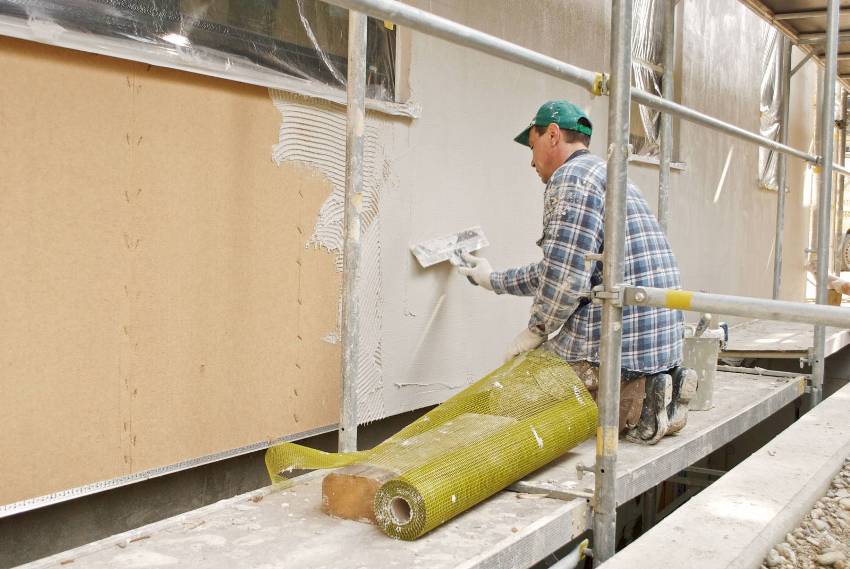
The total cost of the finished wet facade system is the total cost of the constituent components and the work performed
Thus, the price of a wet facade per m² with mineral wool slabs will be about 1200 rubles. A thermal insulation system made of expanded polystyrene will cost much less - about 750 rubles. for 1 m².
Arrangement of a wet facade: the cost of work for m² to order
The total costs of installing insulation and decorating it include payment for the services of craftsmen or contractors. This is if the work is not done independently. The total price ranges from 1,000 to 2,500 rubles per square meter. It all depends on the total amount of work, the type of materials and the method of decorating the finished wall. The main components and the average price of installing a wet facade are shown in the table below:
| Type of work performed | Cost, rubles / m² |
| Installation and dismantling of scaffolding for construction | 130 – 150 |
| Surface priming for deep penetration | 60 – 90 |
| Fastening the insulation with adhesive and leveling the wall | 370 – 450 |
| Installation of a reinforcing layer with a base plaster layer and flush embedding | 330 – 370 |
| Wall priming using quartz sand | 65 – 75 |
| Various types of decorative plastering | 240 – 350 |
| Stone decoration on the facade plinth | 870 – 920 |
A wide range of prices for wet plastering of the facade is justified by the varying degrees of complexity of the decorating process. The list may also include additional work, for example, the installation of decorative elements. Their cost is calculated separately and depends on the complexity.
Additional factors affecting the cost of wet facade works
The above services and their cost are not constant.The list can be much longer, and the price increases due to the appearance of additional costs. The final price per m² of a turnkey wet facade depends on a number of additional factors. In particular, you should consider:
- initial appearance and structure of the facade;
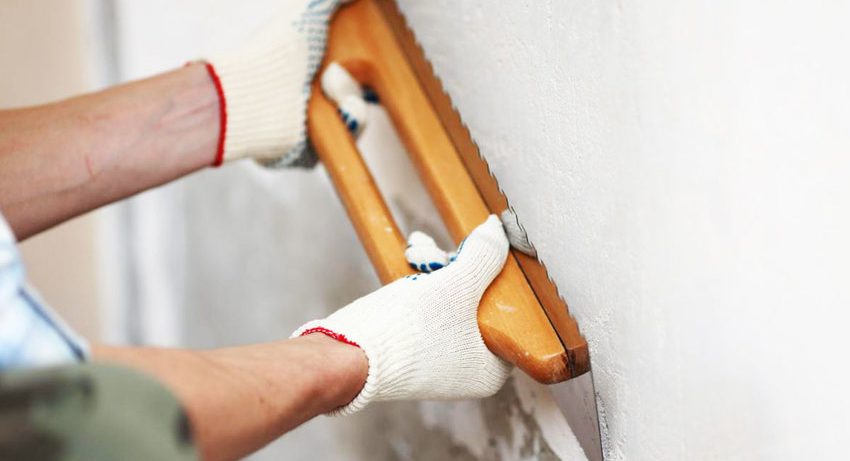
The price per m² of a turnkey wet facade depends on how high-quality the characteristics of the materials and their quantity are
- the presence of flaws and damage;
- the level of complexity of the work performed;
- the total number of openings for doors and windows, as well as their location;
- quality characteristics of materials and their quantity;
- total amount of work.
Helpful advice! The cost calculation is made individually for each specific case. Sometimes, even with an identical list of works and the same processing area, the price can differ significantly.
Therefore, the final cost includes additional costs. For example, labor-intensive work at high heights will require the installation of auxiliary assembly scaffolding. The cost of their rent depends on the height and duration of use. It should also be borne in mind that high-rise work is much more expensive, since it requires special skills and the organization of insurance. Prices are influenced by the costs associated with delivery and the features of individual facades.
Installation of a wet system will cost an order of magnitude less than the arrangement ventilated facade, but its further operation will cost more. The wet facade technology is usually used to insulate private houses, and the ventilated facade is used to decorate larger buildings. What this is connected with, we will consider below.
Ventilated facades: pricedictated by quality
Speaking about the scope of the wet facade method, it is worth mentioning such a feature as limited resistance to the effects of temperature extremes. Based on many years of research, the European Association of Plaster Type Thermal Insulation Systems has come to the conclusion that the wet facade technology is not appropriate in all climatic conditions.
Even the most reliable and expensive materials, installation in compliance with all requirements does not provide a long-term guarantee of service in the conditions of the inland climate of temperate latitudes, which dominates a significant part of the territory of Russia. The scientists of the association took grapes, or rather not the plant itself, but the cycle of its maturation, as the starting point for the application of the wet facade system. That is, in the zone where climatic conditions allow the maturation of at least one of its varieties, the use of technology is advisable.
In conditions of constant rains and high humidity, for example, in close proximity to the sea, the use of this technology is undesirable. This is due to the poor moisture resistance of this type of facade. If the wall will be exposed to frequent mechanical stress, then the installation of a wet facade is also not recommended.
Based on the listed contraindications, an alternative plaster-type facade technology was invented in the form of a hinged thermal insulation system with an air gap. Simply put, a ventilated facade. What are the similarities, differences and advantages of this type of building insulation - we will figure it out further.
Helpful advice! You can check the quality of thermal insulation under a ventilated and wet facade using a thermal imager. Warm tones in the photo show heat loss, and dark tones show the heat resistance of the walls.
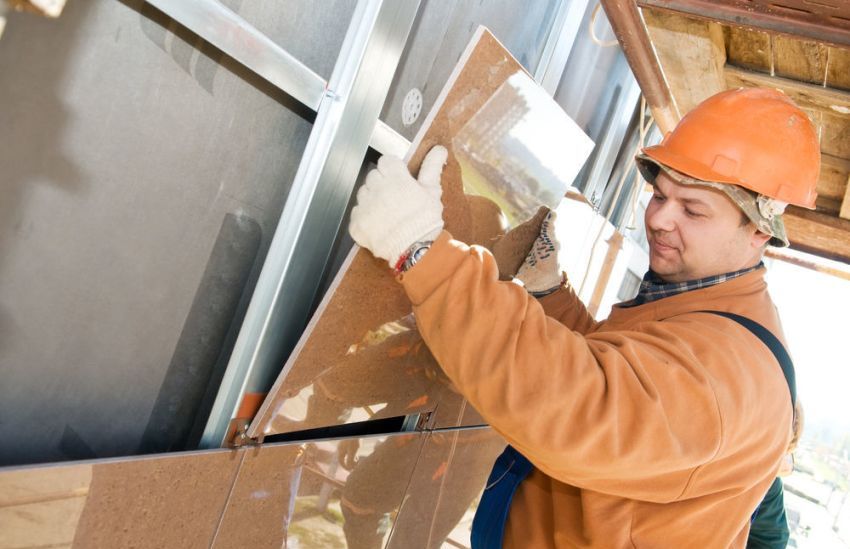
Ventilated facades are mounted on the building without special preliminary preparation of the construction object
Comparative characteristics of ventilated and wet facades: photos of houses and buildings
The curtain system differs from the plaster system in that during the installation of a wet facade, plaster is applied directly to the thermal insulation layer.A ventilated facade involves the installation of a fiber cement facade panel at a certain distance from the insulation, which creates the necessary protection against atmospheric precipitation. In addition, thanks to the protective screen, excess moisture that appears behind the facade panel can evaporate through the air opening.
Thus, the ventilated facade has an additional number of functions in comparison with the wet method and provides:
- additional protection against moisture, as well as sound insulation;
- the highest degree of protection against ignition;
- coolness in the room during the summer, which saves on air conditioners;
- elimination of flaws on the wall in the form of irregularities and curvatures;
- ease and speed of installation;
- a wide range of design options;
- additional thermal insulation, which is facilitated by the presence of an air cushion.
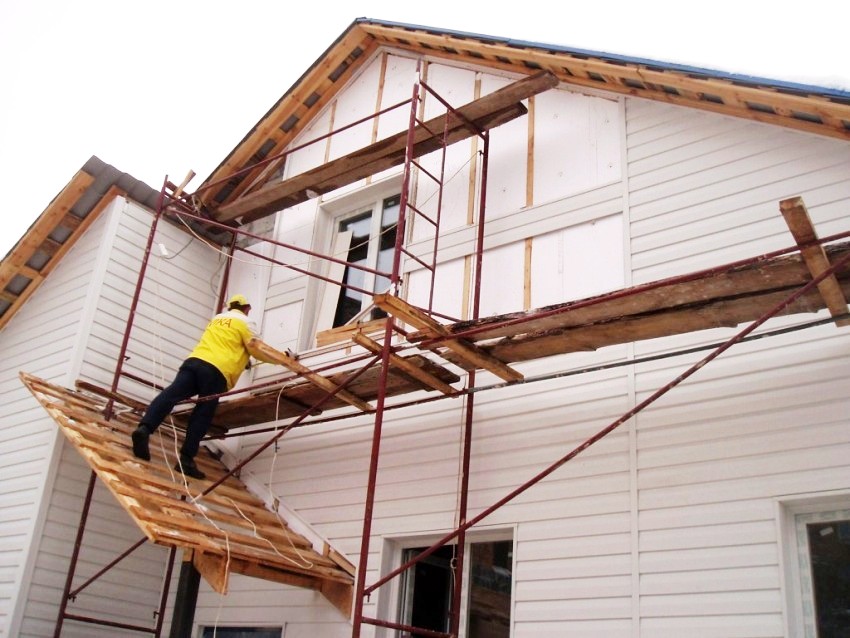
Installation of a ventilated facade can be carried out at any time of the year, in contrast to the wet method
In addition, the fiber cement coating does not require additional maintenance and repair of the decorative layer after several years. The hinged structure can serve for several decades without intervention.
When solving the dilemma of which facade to choose, you can be guided by the following recommendations. A wet facade is advisable when you need to minimize the cost of finishing the building and minimize the load on the walls. In this way, it is possible to design perfectly smooth walls without observing special requirements for the strength and durability of the facade.
The curtain cladding, in turn, compensates for the unevenness of the wall and helps to hide any defects. Installation of the ventilation façade can be carried out at any time of the year, even at subzero temperatures.
Areas of application for wet façade and ventilated façades
The scope of application of ventilated facades is much wider. They are used for insulating private houses, finishing multi-storey new buildings and public buildings. The most widely used for decorating shops, cafes, shopping and entertainment centers and other public and commercial institutions.
Important! Wet facades are used for thermal insulation of low-rise buildings and utility rooms, as well as, if necessary, to save on insulation. As a budget option, this method is also applicable in the energy saving system of government agencies and public buildings.
Various materials are used in the cladding of ventilated facades, in particular:
- porcelain stoneware plates;
- aluminum and composite panels;
- fiber cement;
- laminate boards manufactured under high pressure.
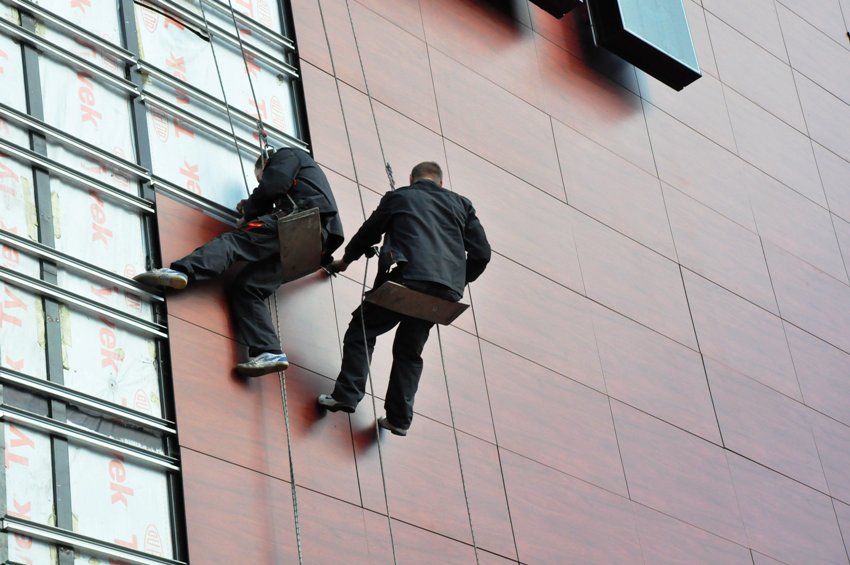
Suspended ventilated facades are successfully used for external finishing of buildings of any purpose and type
The main advantages of a porcelain stoneware facade are its strength, varied colors and high aesthetic characteristics. But such material is quite expensive. The price of aluminum composite panels is more affordable. The material itself is universal, and thanks to a wide range of colors and structures, it allows the most daring fantasies of an architect to come true.
Fiber cement is a stone-like material that is resistant to moisture and sun. Differs in ease of installation and open mounting type. It is most often used for cladding residential buildings. Laminate panels are a new material that has different colors, textures, is resistant to weathering and fire, it is lightweight, durable and environmentally friendly. In addition, it is cheaper than porcelain stoneware counterparts.
Mineral wool wet facade technology: instructions, useful tips and secrets of the masters
If, after considering all kinds of insulation options, the choice was made in favor of a wet facade using mineral wool slabs, and it was decided to do the work independently, then it is necessary to take into account a number of secrets of the masters.
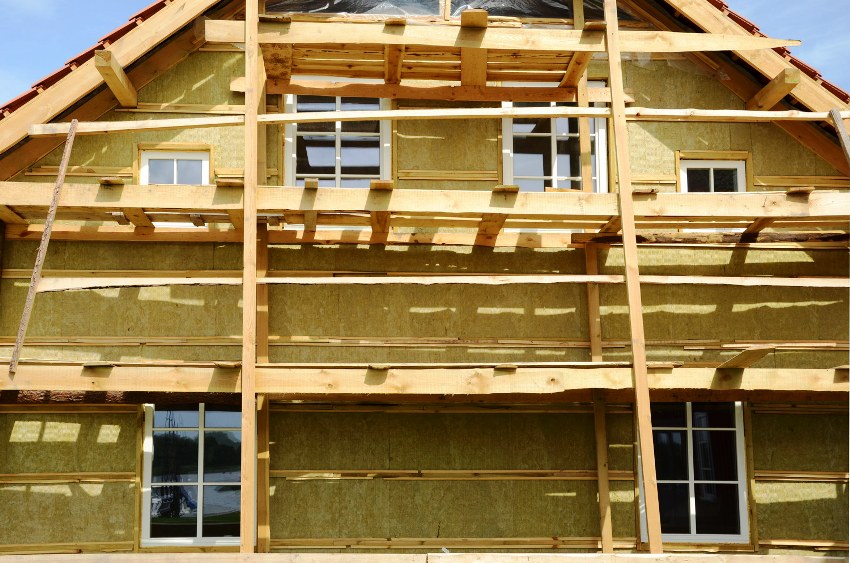
With the right choice of material and following the instructions, the warranty period of a wet facade with mineral wool insulation can reach 40 years
It's worth starting with the choice of material. So, on the Internet and in special literature, you can find a recommendation regarding the replacement of mineral wool with fiberglass. This is a misconception, since over time, fiberglass plates begin to sag under vibration influences, and so-called cold paths are formed in the insulation layer.
To achieve the maximum thermal insulation effect, it is worth taking care of not only insulation of the facade, but also of the floor and ceiling. In particular, this applies to apartments above unheated rooms or on upper floors.
Provided the correct choice of material and strict adherence to the instructions, the warranty period of the facade can reach half a century. Additional protection of the finishing layer of plaster will be provided by coating with a special paint, which will also extend its service life. For this purpose, it is worth using a water-based paint with acrylic, silicone or silicate impurities. Its color variety includes over a thousand shades.
Helpful advice! During painting, you should look into the design and estimate documentation, where the original color of the building is indicated - the new shade must match it.
Conditions for successful insulation using the technology of installing a wet facade: video recommendations
Thermal insulation using wet technology must take place under conditions of complete protection from frost and precipitation. If the work does not require delay and its completion takes place in unfavorable conditions, then you should take care of the construction of special scaffolding and cover them with a dense film, which will provide temporary protection from wind and moisture and create a small thermal circuit.
Before starting work on the installation of a wet facade, it is necessary to tightly close all accesses to the interior of the room from the side of windows and doors. It is better to complete all internal rough work in the house before the start of insulation. On the outside wall, a number of fixtures and brackets should be placed in advance that will hold air conditioners, cameras, ebb or downpipes.
It is necessary to work with adhesive solutions in the shade or in case of increased cloudiness, excluding as much as possible sunlight on the mixture. The distance between the thermal insulation boards and the reinforcing mesh must be at least 2 mm, which allows the glue to be cast.
For the overall strength of the multi-layer structure, it takes several days for each layer to dry. Haste in this case is unacceptable. The performance characteristics of decorative plaster depend on the working conditions. Optimal prerequisites are temperatures above 5 ° С, increased cloudiness, dry calm weather.
For plaster, it is necessary to select only materials for outdoor work that can fully withstand negative influences. The top plaster layer must have a high level of thermal conductivity and moisture resistance, be durable and resistant to mechanical, chemical and weathering.
House insulation wet facade: summarizing
The wet facade technology, although inferior in a number of performance characteristics to the ventilated facade, is the leader among the existing insulation methods. Its advantages lie in the use of modern high-quality heat-insulating materials, the service life of some of them can reach half a century. A special exterior finish with high aesthetic characteristics not only guarantees the external beauty of modern residential buildings, but also makes this technology permissible in the restoration of architectural landmarks.
To achieve the best result, you need to trust the work of certified firms, as well as use high-quality materials from manufacturers that have proven themselves in the construction market. To prevent the occurrence of chemical reactions, it should be noted that the individual components must be compatible with each other. Each subsequent layer must have an increased level of vapor permeability in relation to the previous one. Do not forget about the strength and density of materials and their compliance with fire and environmental requirements.
The design is designed to provide a high degree of sound protection in two directions (both from inside and outside the house). The quality of materials affects the longer service life of not only the insulation layer, but also the whole house, protecting the walls from precipitation and mechanical damage. The facade covers the main structure from the effects of wind, frost, pollution, ultraviolet radiation and humidity.
In conclusion, it should be noted that the use of various options for decorative plaster in the wet facade system, finishing elements and color design makes it possible to implement various style ideas on the outside of the building, which cannot be done using other methods of insulation, for example, ventilated facade technology.
